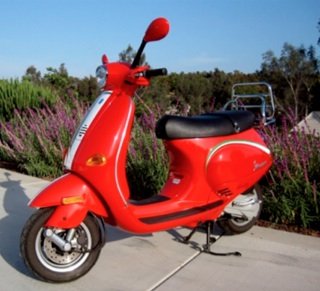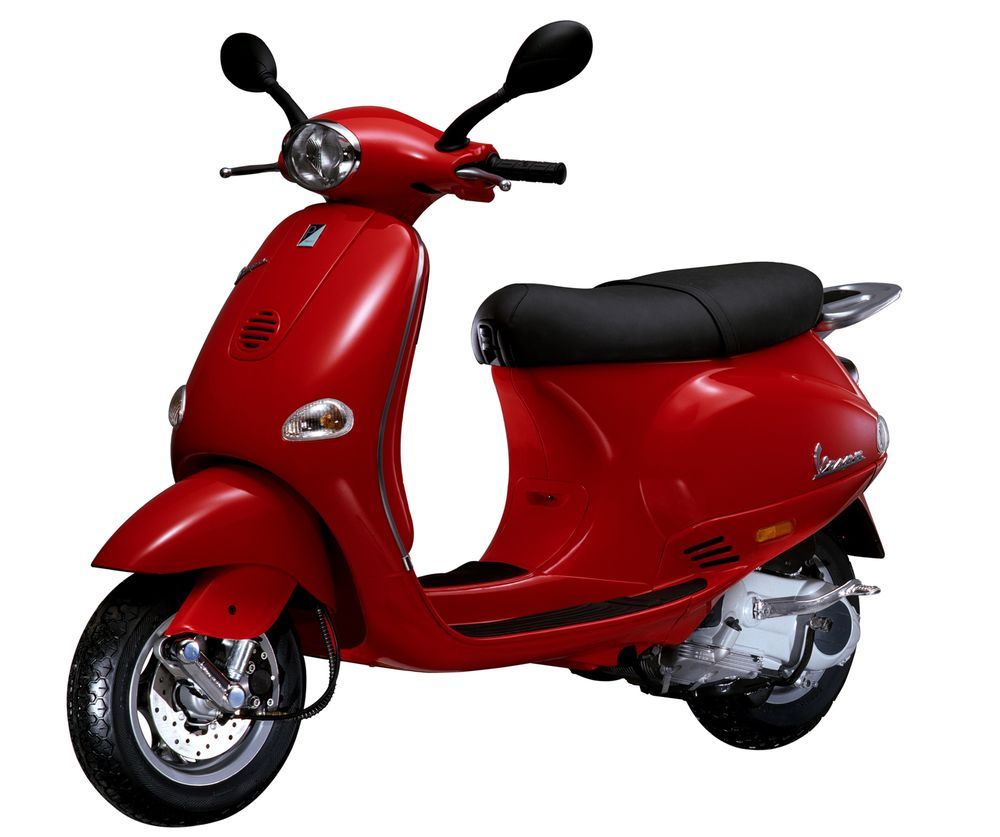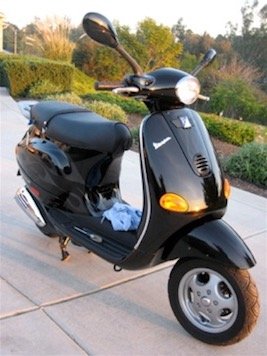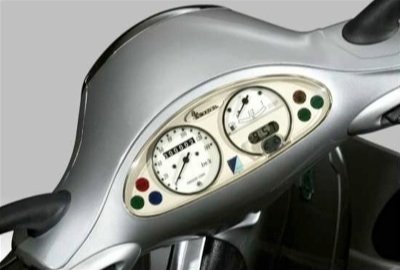VESPA ET SERIES
The ET series of Vespa scooters was launched in Europe in 1996, 50 years after the first Vespas were sold. The ET series of Vespa scooters was significant, as it was Vespa’s long awaited attempt to move beyond 2-stroke engines. The ET chassis was Vespa’s first to be capable of accommodating both 2-stroke (ET2) and 4-stroke (models named ET4) engines and in sizes from 50cc to 150cc.
With this new generation of scooter capable of meeting stringent emissions regulations, Vespa returned to the USA market in late 2001 after an 18 year absence. Vespa brought two versions of their ET scooter to the USA market. They sold the ET2 50 (2-stroke, 50cc) and the more powerful ET4 150 (4-stroke, 151cc).
Both of these scooters shared the same frame, suspension, wheels, brakes and styling. All that was different was the motor. These scooters were sold here until they were replaced for 2006 with the new LX generation.
 Styling
Styling
The ET was the first major new design from Vespa since the PX design of the late 70’s. As such, it was a significant change for Vespa. The PX generation was the most boxy generation of Vespa’s, so the highly rounded ET series was a very different direction for this Italian firm. Reaction to the ET series was mixed, with some people enjoying the modern look while other long time fans found it to be too significant of a departure from the Vespa tradition.
Design & Convenience
Unequivocally, this new generation of Vespa scooters set the bar high for features in a scooter. The ET scooters included a neat microchip key to deter thieves, real chrome accents and a front disc brake. It is great to see the quality that Vespa puts into their scooters. Unlike a lot of scooter companies, Vespa isn’t concerned with bringing their scooters to market as low cost as possible.
One strong point of the ET scooters is their enclosed storage space. These scooters have both a generous glovebox and a large storage space under the seat that can hold a full face helmet. By using these two areas and the grocery bag hook on the front of the seat, you can really haul a lot of stuff.
 Brakes / Suspension / Handling
Brakes / Suspension / Handling
Braking is also strong in these scooters thanks to the front disc brake. Front disc brakes are pretty standard on many 150cc scooters but you don’t see too many 50cc’s with a front disc brake – especially not in 1996 when these scooters were released. The rear brake is a drum unit which works fine.
On the downside, these scooters are a bit clumsy to maneuver at low speeds because of their hefty weights and higher seats. The other downside of these scooters is that their one piece steel frame/body is very expensive to repair if you get a dent in it. Unlike other scooters, you can’t replace the body panels so any dents or scratches will need to be expertly repaired. To many enthusiasts this metal body is a strong selling point and it does have a high quality feel to it, so a certain trade off exists.
Motor
In the performance department, the ET scooters performed well. The 2-stroke ET2 50 was peppy and could easily reach 40 mph (65km/hr), even with a passenger. The larger 151cc ET4 was capable of about 60mph which makes it sufficient for venturing out of town.
The 4-stroke engine found in the North American market ET 150 scooters was a LEADER engine that differed from the older 4-stroke design used in ET4 150’s elsewhere prior to 2001. The LEADER powered ET4 150 posted much better fuel numbers than the earlier ET4’s, with typically milage in the 60-65mpg range. These were good numbers for its time, while newer fuel injected 150’s can achieve about 10mpg higher. This LEADER engine is the same motor as Vespa continued to use in their LX 150 and S 150, so performance is similar. In addition to the LX and S 150 models, the LEADER engine was widely used in other Piaggio products in the years since (ie. Piaggio Fly 150, Aprilia Mojito 150). As such, both OEM and aftermarket parts availability is excellent.

Comparison
Vespa’s ET series of scooters are great machines. If you can afford the price, they are great scooters to own because they do hold their value well and quality is top notch. If you’re more price sensitive, check out the offerings from Yamaha, Kymco and Honda. These scooters do not offer all the features of a Vespa, but they are nice scooters that get better milage and are lower cost.
When the ET scooters were first introduced, no one else was selling classically styled scooters in North America. Yamaha and Honda did respond quickly though, with Honda’s Metropolitan being added for 2002. Yamaha began selling their the Vino 50 and 125 in 2003 and 2004 respectively. In the decade since, a lot has changed and now Vespa offers new models in this category, while Honda, Yamaha and several Taiwan makers (Kymco, SYM et al) continue to target the lower priced end of Vespa’s niche.
Pros:
- Underseat storage
- Vespa quality
- Anti-theft microchip key
- Front disc brake
- Loads of aftermarket parts available
Cons:
- Mediocre mileage
- Heavy (due to steel frame)
- High seat height
Links:
MotorscooterGuide Forums – Visit the forum on this site to chat about this scoot.
Modern Vespa Forums – Lots of knowledgeable Vespa owners here.
Vespa ET4 50 Service Manual – The official guide to working on your ET4
Key Specs:
- ET2 50 Engine: Single cylinder, 49.4 cc, 2 stroke Piaggio Hi-PER2 with two way catalytic converter
- ET4 150 Engine – Single cylinder, 149.6cc, 4 stroke, SOHC, 2-valve, air cooled Piaggio LEADER
- Bore & Stroke: 40mm x 39.3mm (ET2 50), 62.6 x 48.6mm (ET4 150)
- Power: 5.1hp (ET2 50), 11.3hp (ET4 150)
- Compression ratio: 10.3: 1 (ET2 50), 10.1 (ET4 150)
- Ignition: Electronic capacitive (CDI), fixed advance 17°
- Starter: Electric and kick starter
- Lubrication: Automatic mixer
- Cooling: Forced Air
- Transmission: CVT automatic, torque server
- Clutch: Automatic dry centrifugal type
- Frame: Pressed steel frame, welded support elements
- Front suspension: Oscillating arm, coil spring, dual effect hydraulic single shock
- Rear suspension: Coil spring, dual effect hydraulic single shock absorber
- Front brake: Stainless steel, 200 mm disk
- Rear brake: 110mm drum
- Front rim: Pressed die cast aluminium alloy, 2.50-10″
- Rear rim: Pressed die cast aluminium alloy, 3.00 – 10″
- Front tire: Tubeless 100/80-10″
- Rear tire: Tubeless 120/70-10″
- Length: 69.3” / 1760 mm
- Width: 26.4” / 670 mm
- Wheel base: 50.4” / 1280 mm
- Seat height: 31.7” / 805 mm
- Dry weight: 216 lbs (ET2 50), 236 lbs (ET4 150)
- Fuel tank: 9 litres / 2.5 gallons
- Recommend Fuel: Unleaded 92 octane
- Fuel milage: 65mpg (ET2 50), 41mpg (ET4 150)
- Colors: Black, White, Pearl White, Seafoam Green, Blue, Dragon Red and Alabaster.


 Styling
Styling Brakes / Suspension / Handling
Brakes / Suspension / Handling